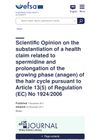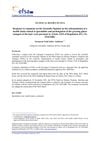305 citations,
March 2008 in “AJP Endocrinology and Metabolism” Spermidine/spermine-N(1)-acetyltransferase (SSAT) was identified as a crucial enzyme regulating cellular polyamine content, impacting normal and neoplastic growth, ion channel regulation, and potentially cancer chemotherapy. SSAT activity was highly regulated and could be induced by various stimuli, affecting polyamine homeostasis and linking polyamine metabolism to lipid and carbohydrate metabolism. Increased SSAT activity led to a futile cycle consuming ATP and acetyl-CoA, and was associated with adverse effects such as pancreatic cell death, tissue growth blockage, behavioral changes, and hair loss. SSAT also interacted with proteins like hypoxia-inducible factor-1 alpha and NF-kappaB, though the exact mechanisms were unclear. While SSAT was considered a potential target for diseases beyond cancer, its broad physiological effects necessitated careful targeting to avoid toxicity.
 1 citations,
December 2011 in “EFSA Journal”
1 citations,
December 2011 in “EFSA Journal” Spermidine may help extend the growth phase of hair.
 July 2012 in “EFSA supporting publications”
July 2012 in “EFSA supporting publications” The EFSA maintained its view that spermidine's effect on hair growth is related to disease treatment and does not meet the health claim criteria.
128 citations,
December 2006 in “Journal of Biological Chemistry” The study explored how altering the expression of spermidine/spermine N1-acetyltransferase (SSAT) affected fat metabolism in mice. Transgenic mice overexpressing SSAT showed increased metabolic activity through the polyamine pathway, resulting in a leaner phenotype with reduced white adipose acetyl- and malonyl-CoA pools and enhanced glucose and palmitate oxidation. In contrast, SSAT knockout mice had decreased metabolic flux, increased body fat, and lower oxidation rates, especially on a high-fat diet. These results indicated that SSAT expression influenced acetyl- and malonyl-CoA levels, affecting fatty acid biosynthesis and oxidation, and thus body fat accumulation. The study underscored the role of SSAT in polyamine metabolism and its impact on fat metabolism via acetyl-CoA modulation.
54 citations,
February 2002 in “Carcinogenesis” The study used transgenic mice with targeted expression of spermidine/spermine N1-acetyltransferase (SSAT) in hair follicle keratinocytes to investigate susceptibility to skin cancer. These K6-SSAT transgenic mice, bred onto a tumor-resistant C57BL/6 background, showed a 10-fold increase in epidermal tumors when exposed to a carcinogenesis protocol involving 7,12-dimethylbenz[a]anthracene and 12-O-tetradecanoylphorbol-13-acetate. The transgenic mice exhibited elevated SSAT activity and protein levels, along with increased putrescine and N1-acetylspermidine, indicating enhanced polyamine catabolism. The study concluded that this activation of polyamine catabolism might play a crucial role in chemically induced skin cancer, as evidenced by the early onset and progression to carcinomas in the transgenic mice.
43 citations,
February 1999 in “Biochemical Journal” The study involved generating a transgenic mouse line overexpressing the SSAT gene under a mouse metallothionein I promoter, leading to significant changes in tissue polyamine pools and delayed permanent hair loss compared to previous models. The liver was notably affected, with altered polyamine levels. Despite high SSAT mRNA levels, enzyme activity was only moderately increased unless induced by ZnSO4 or the polyamine analogue DENSPM, which caused a dramatic increase in enzyme activity and depletion of liver polyamines, resulting in high mortality and liver damage. The findings suggested that SSAT overexpression made the mice highly sensitive to polyamine analogues, indicating a post-transcriptional regulation mechanism.
37 citations,
February 2005 in “Journal of Investigative Dermatology” Overexpression of spermidine/spermine N1-acetyltransferase (SSAT) in transgenic mice led to putrescine accumulation in the skin, resulting in permanent hair loss by 3 weeks of age, with hair follicles replaced by dermal cysts and epidermal utriculi. This condition mirrored hyperproliferative cutaneous disorders like psoriasis, characterized by delayed epidermal differentiation and altered expression of differentiation markers. Immunohistological analysis confirmed disturbed differentiation in SSAT transgenic skin, and similar changes were observed in organotypic cultures of transfected rat epidermal cells. Reducing putrescine levels through biosynthesis inhibition alleviated skin changes and allowed hair regrowth, indicating that keratinocyte differentiation disorders were responsible for the cutaneous changes in SSAT transgenic mice. This highlighted the importance of polyamine metabolism regulation in keratinocyte maturation.
13 citations,
March 1999 in “Biochemical Journal” The study involved generating a transgenic mouse line overexpressing the SSAT gene under a mouse metallothionein I promoter, leading to significant changes in tissue polyamine pools and delayed permanent hair loss compared to previous models. The liver was notably affected, with drastic reductions in spermine and increases in putrescine. Despite high levels of SSAT mRNA, enzyme activity was only moderately elevated unless induced by ZnSO4 or the polyamine analogue DENSPM, which caused a massive increase in enzyme activity and depletion of spermidine and spermine pools. This treatment led to high mortality and liver damage, indicating that SSAT overexpression made the mice highly sensitive to polyamine analogues, suggesting a post-transcriptional regulation mechanism.
3 citations,
April 2002 in “Animal Science” The study investigated the effects of intradermal spermidine injections on wool follicle growth in Merino lambs. Three groups of eight lambs received different concentrations of spermidine injections on a small skin patch, with saline as a control on the opposite side. Results showed that spermidine increased the concentration in the skin and stimulated cell division in the follicle bulb, with higher doses leading to greater increases. Fibre length growth rate was also higher with spermidine, although fibre diameter did not change significantly. The study concluded that spermidine injections altered skin spermidine homeostasis, stimulated cell proliferation, and increased fibre growth.
2 citations,
May 2006 in “Journal of Separation Science” The study developed a capillary gas-chromatographic method to quantitatively determine spermidine (SPD) in hair lotions, which was believed to promote hair growth. The method involved using 1,6-diaminohexane as an internal standard, a methyl silicone capillary column, and a flame ionisation detector. Hair lotion samples were treated with an alkaline solution, extracted with diethyl ether containing ethyl chloroformate, and analyzed after reconstitution in ethyl acetate. The method was validated for specificity, linearity, precision, and accuracy, confirming its effectiveness for measuring SPD in hair lotions.
3 citations,
June 2011 in “EFSA Journal” The document evaluated the health claims related to spermidine and its contribution to normal hair growth. The Panel on Dietetic Products, Nutrition and Allergies assessed the scientific evidence provided to substantiate these claims. The conclusion was that a cause-and-effect relationship between the consumption of spermidine and the contribution to normal hair growth was not established due to insufficient evidence. The panel emphasized the need for more robust scientific data to support such health claims.
54 citations,
May 2001 in “Journal of Investigative Dermatology” 2 citations,
November 2017 in “Histochemistry and Cell Biology” 124 citations,
July 1997 in “Journal of Biological Chemistry” In this study, researchers created a transgenic mouse line that overexpressed spermidine/spermine N^1-acetyltransferase, leading to significant alterations in tissue polyamine pools. These changes included the presence of N^1-acetylspermidine, an unusual accumulation of putrescine, and reduced levels of spermidine and spermine. The most notable phenotypic effect was permanent hair loss in mice aged 3 to 4 weeks, associated with the formation of follicular cysts in the dermis, likely due to putrescine's interference with hair follicle cell differentiation and proliferation. Additionally, female mice were infertile, linked to ovarian hypofunction and underdeveloped uteri. This research highlighted the potential of using spermidine/spermine N^1-acetyltransferase overexpression to manipulate polyamine levels in transgenic animals for studying developmental and cancer-related outcomes.
 10 citations,
June 2001 in “Annals of neurology”
10 citations,
June 2001 in “Annals of neurology” Alzheimer's patients have higher levels of certain chemicals in their hair.
91 citations,
July 2004 in “Journal of Biological Chemistry” The study explored the impact of overexpressing the enzyme spermidine/spermine N1-acetyltransferase (SSAT) in TRAMP mice, a model for prostate cancer. By cross-breeding these mice with SSAT-overexpressing mice, researchers observed a significant reduction in tumor growth, with genitourinary tract weights being 4 to 12 times less than in TRAMP mice alone by 30 to 36 weeks of age. This tumor suppression was attributed to increased polyamine catabolism, which depleted acetyl-CoA and S-adenosylmethionine, despite increased polyamine biosynthesis. Histopathological analysis showed less advanced tumors in TRAMP/SSAT mice, suggesting that SSAT overexpression could be a promising therapeutic strategy for prostate cancer. Additionally, a genitourinary disease index was developed to assess the treatment's impact, particularly in the C57BL/6 mouse background.
10 citations,
August 2013 in “Experimental Dermatology” The study explored the interaction between the nuclear protein Hairless (HR) and the polyamine putrescine in the epidermis, revealing a negative regulatory loop. Mutations in HR and overexpression of polyamine enzymes like ornithine decarboxylase (ODC) and spermidine/spermine N1-acetyltransferase (SSAT) led to hair loss and skin papules. The research showed that decreased HR levels resulted in increased ODC expression, and this regulation was influenced by the MYC superfamily of proteins. Elevated putrescine levels reduced HR expression, but the effects differed from HR mutations. Microarray analysis indicated that putrescine affected genes related to protein interactions and transcription, suggesting significant implications for epidermal homeostasis and hair follicle cycling.
42 citations,
February 1996 in “Journal of Investigative Dermatology” The study investigated the role of polyamines in hair follicle function and fiber composition in sheep. It found that inhibiting ornithine decarboxylase with alpha difluoromethylornithine altered fiber characteristics but did not inhibit wool follicle growth in culture. Conversely, inhibiting S-adenosylmethionine decarboxylase with methylglyoxal (bis)guanylhydrazone completely inhibited fiber growth, which could be reversed by adding spermidine, but not spermine. The study concluded that polyamines, particularly spermidine, were crucial for hair growth, as evidenced by the ability of spermidine to partially counteract growth depression in methionine-deficient conditions.
 14 citations,
January 2001 in “Clinical chemistry”
14 citations,
January 2001 in “Clinical chemistry” Hair can be used to measure cancer-related chemicals noninvasively.
 12 citations,
December 2009 in “Amino Acids”
12 citations,
December 2009 in “Amino Acids” Putting α-methylspermidine on mouse skin can start hair growth.
 5 citations,
October 2013 in “Experimental Dermatology”
5 citations,
October 2013 in “Experimental Dermatology” The commentary explains that a balance of HR protein and putrescine is important for normal hair growth.
 215 citations,
March 2018 in “Archives of Toxicology”
215 citations,
March 2018 in “Archives of Toxicology” Tiny pollution particles called PM2.5 can harm skin cells by causing stress, damage to cell parts, and cell death.
 115 citations,
January 2001 in “American journal of clinical dermatology”
115 citations,
January 2001 in “American journal of clinical dermatology” Eflornithine cream effectively reduces women's unwanted facial hair but hair returns if treatment stops.
 106 citations,
March 2014 in “BioEssays”
106 citations,
March 2014 in “BioEssays” We need more research to better understand human hair follicle stem cells for improved treatments for hair loss and skin cancer.
 106 citations,
April 2010 in “ACS Nano”
106 citations,
April 2010 in “ACS Nano” C60 fullerenes can alter protein function and may help develop new disease inhibitors.
 98 citations,
July 2014 in “Trends in Molecular Medicine”
98 citations,
July 2014 in “Trends in Molecular Medicine” Hair follicles are hormone-sensitive and involved in growth and other functions, with potential for new treatments, but more research is needed.
 87 citations,
May 2012 in “PLOS Genetics”
87 citations,
May 2012 in “PLOS Genetics” Six new genetic regions linked to early hair loss also connect to Parkinson's disease and prostate cancer, possibly leading to new treatments.
 81 citations,
January 2006 in “Journal of cellular physiology”
81 citations,
January 2006 in “Journal of cellular physiology” Mice without the vitamin D receptor gene lose hair due to disrupted hair follicle cycles.
 72 citations,
December 1983 in “Journal of Investigative Dermatology”
72 citations,
December 1983 in “Journal of Investigative Dermatology” Minoxidil helps hair cells live longer and grow longer.
 30 citations,
June 1988 in “Journal of Steroid Biochemistry”
30 citations,
June 1988 in “Journal of Steroid Biochemistry” Flutamide combined with an LHRH agonist effectively inhibits prostate growth, suggesting it could treat prostate cancer.














